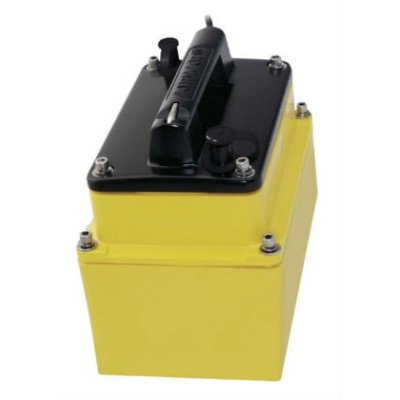- Χωρίς απόθεμα




XSONIC AIRMAR M260. Ο M260 είναι ένας πλαστικός/ουρεθανικός αισθητήρας ευρυζωνικής ζώνης μέσα στο σκάφος, ιδανικός για μικρότερα αλιευτικά και εμπορικά σκάφη 8 m (25 ft) και άνω, που αλιεύουν σε βάθη μικρότερα από 900 m (3000 ft). Μαύρος σύνδεσμος 9 ακίδων
Operating at 50 and 200 kHz, the narrow, 6° beam at 200 kHz provides excellent target resolution and crisp images of fish holding tight to wrecks and reefs. The 50 kHz is excellent at deep-water detection, and the wide 19° beam yields broad coverage under the boat.
The transducer is installed inside the hull in the included tank. The tank is cut to the boat’s deadrise angle to ensure that the transducer is properly oriented for optimal performance. The M260 is a popular choice for customers not wanting to drill holes in their hull and for trailered boats.
Features
| Weight | 6.2 kg (13.5 lb.) |
| Recommended Boat Length | Up to 36' |
| Hull Material | Solid fiberglass only |
| Hull Deadrise | up to 30° with modified tank |
| Acoustic Window | Layered plastic urethane (LPU) |
| Includes | Tank and mounting hardware |
Xsonic SS75M από ανοξείδωτο ατσάλι 600W Thru Hull μεσαίο CHIRP (80-130kHz) Βάθος/Θερμοκρασία (0° tilt) : Μαύρο βύσμα 9 pin: Μήκος καλωδίου 10m (33.0 ft)
SS260 - Ανοξείδωτος αισθητήρας βάθους/θερμοκρασίας 50/200 kHz 1kW Fairing-Block Through-Hull. Μαύρη υποδοχή 9pin και καλώδιο 10m (33ft).
Xsonic P79 Plastic 600 W In-Hull 50/200 Khz Depth Only : Μαύρο βύσμα 9 ακίδων: Μήκος καλωδίου 10 m (33.0 ft).
XSONIC SS175M 0 degree Medium CHIRP μέσω του αισθητήρα σκάφους. Μαύρος σύνδεσμος 9 ακίδων: Μήκος καλωδίου 10 m (33. 0 ft)
B150M - Χάλκινος αισθητήρας βάθους/θερμοκρασίας Thru-Hull 300W Medium-Chirp. Σύνδεσμος 9pin με καλώδιο 10m (33ft).
Ο P75M είναι ένας αισθητήρας 600 W, chirp-ready, που λειτουργεί στη ζώνη μεσαίων συχνοτήτων 80 έως 130 kHz. Αυτό το εύρος ζώνης είναι ιδανικό για παράκτια αλμυρά νερά
Αισθητήρας HDI Through-Hull. 50/200kHz 455/800 kHz DownScan. Μαύρη υποδοχή 9 ακίδων και καλώδιο 10m (33ft).
Αισθητήρας βάσης StructureScan™ HD Skimmer
B150M - Χάλκινος αισθητήρας βάθους/θερμοκρασίας Thru-Hull 300W Medium-Chirp. Σύνδεσμος 9pin με καλώδιο 10m (33ft).
Το M265LH της Airmar είναι εξοπλισμένο με μια συστοιχία επτά στοιχείων, χαμηλής συχνότητας που λειτουργεί μεταξύ 42 και 65 kHz για εξαιρετική απόδοση σε βαθιά νερά. Το κεραμικό υψηλών συχνοτήτων λειτουργεί μεταξύ 130 και 210 kHz με στενό εύρος ζώνης, 10° έως 6°, ιδανικό για τη διάσπαση της δομής και τον εντοπισμό ψαριών που κρατούν σφιχτά τη δομή.
XSONIC SS75M από ανοξείδωτο ατσάλι 600W Thru Hull μεσαίο CHIRP (80-130kHz) Βάθος/Θερμοκρασία (12° tilt) : Μαύρο βύσμα 9 pin: Μήκος καλωδίου 10m (33.0 ft)
B285M - Χάλκινος αισθητήρας βάθους και θερμοκρασίας 1kW Τhrough Hull Medium-Chirp. Σύνδεσμος 9 ακίδων και καλώδιο 10m.
XSONIC SS60 αισθητήρας από ανοξείδωτο ατσάλι 600W Thru Hull 50/200 Khz Βάθος/Θερμοκρασία (12° tilt) : Μαύρο βύσμα 9 pin: Μήκος καλωδίου 10m (33.0 ft)
XSONIC SS60 από ανοξείδωτο ατσάλι 600W Thru Hull 50/200 Khz Βάθος/Θερμοκρασία (20° tilt) : Μαύρο βύσμα 9 pin: Μήκος καλωδίου 10m (33.0 ft)
